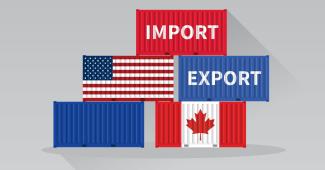
How U.S. Tariffs Could Impact Canadian Cities—Who’s Most at Risk?
With the recent U.S. tariffs on Canadian goods back in effect, the economic landscape in Canada is shifting. While the impact will be felt nationwide, some cities are at significantly higher risk than others. New data from the Canadian Chamber of Commerce Business Data Lab (BDL) reveals which regions are most vulnerable to the economic fallout.
Which Cities Are Most at Risk?
Not all Canadian cities will experience the effects of tariffs equally. The Tariff Exposure Index ranks cities based on how much of their economy is tied to industries targeted by U.S. tariffs. Here’s a look at the top five most exposed cities:
- Saint John, NB (131.1% Tariff Exposure)
- Home to Canada’s largest oil refinery, 80% of Saint John’s oil exports go to the U.S.
- Higher tariffs could disrupt this supply chain, affecting local jobs and economic stability.
- Calgary, AB (81.6% Tariff Exposure)
- As a major fossil fuel export hub, Calgary faces risks from the 10% energy tariff imposed by the U.S.
- Alberta’s cattle industry, which exports heavily to the U.S., could also be hit hard.
- Windsor, ON (61.7% Tariff Exposure)
- A cornerstone of Canada’s auto manufacturing industry, Windsor relies on cross-border trade.
- Tariffs on automotive parts could threaten thousands of jobs in the city.
- Kitchener-Waterloo, ON (43.0% Tariff Exposure)
- A major manufacturing hub, Kitchener-Waterloo exports machinery and industrial equipment, which are now under tariff scrutiny.
- Brantford, ON (27.8% Tariff Exposure)
- Known for steel and aluminum production, Brantford could see significant challenges if U.S. demand drops.
What About Other Cities?
- Saguenay, QC (23.5%) – A major aluminum hub, where one-fifth of the economy depends on U.S. exports.
- Hamilton, ON (19.8%) – Canada’s steel capital, which could see ripple effects throughout the steel and manufacturing supply chain.
- Trois-Rivières, QC (18.9%) – Home to paper and pulp industries that rely on exports to the U.S.
On the other end of the spectrum, cities like Halifax (-35.1%), Regina (-40.9%), and Winnipeg (-50.6%) are less dependent on U.S. trade, making them less vulnerable to tariff-related disruptions.
Why Are Certain Cities More at Risk?
- Manufacturing Hubs
- Cities with a high concentration of automotive, steel, and industrial manufacturing are particularly vulnerable.
- Example: Windsor and Hamilton, where the auto and steel industries depend on cross-border supply chains.
- Energy & Natural Resources
- Cities tied to oil, gas, and aluminum production face high risk due to export-heavy industries.
- Example: Saint John and Calgary, both key players in the energy sector.
- Agriculture & Trade Ports
- Canadian beef exports to the U.S. face new hurdles, impacting Alberta's cattle industry.
- Port cities like Vancouver are slightly shielded due to a more diversified set of trading partners.
What’s Next?
While the tariffs pose challenges, Canadian policymakers and businesses have had time to prepare. Canada is retaliating with $20 billion in countermeasures, aimed at protecting domestic industries.
For businesses, understanding your city’s tariff exposure is key to adapting and mitigating risk. Those in high-exposure industries should explore alternative trade partners, supply chain diversification, and potential government relief programs.
Final Thoughts
The tariff battle is far from over, and Canadian cities will feel its effects in different ways. Whether you're in a high-risk sector or not, staying informed and preparing for economic shifts is more important than ever.

